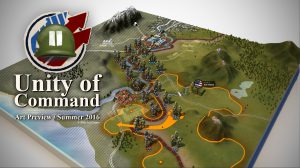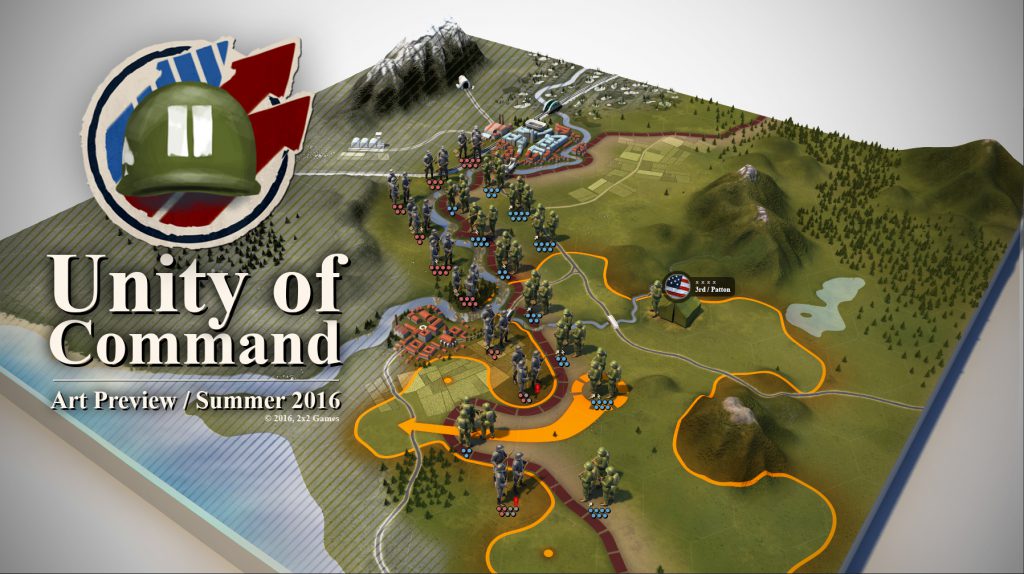
Yes, this is what you think it is. Find a few more details about the new look at bottom of this post.
“I do not intend to send any more evening situation reports until the war becomes more exciting”
— Field Marshal Montgomery, one day prior to Battle of the Bulge.
A full update on the campaign game will take more than one post, but you need to start somewhere, so here it goes: an introduction. Check out the pretty pic to your left (you’re welcome!) and relax – it won’t be too long.
At its very core, the campaign game stays the same: you play at the operational level, meaning you don’t control production, politics, and diplomacy. Furthermore, since you’re playing all the battles, you are not playing as any one commander individually. In fact, you’re standing in for the entire operational-level stratum of your faction’s military, literally all of the three- and four star generals commanding at army and theater level.
While staying within that scope, we lined up a bunch of improvements atop the somewhat bare-bones campaign game of UoC1. As usual, your performance matters. Not only do you earn prestige, but the end situation in one battle will determine your position at the start of the next. The exact front lines won’t be 1:1, but key areas like objectives and bridgeheads will generally carry over.
We also want your units to be more than just disposable game pieces. Both the player and the AI get to reinforce between most scenarios, but heavy casualties, or units getting wiped out will definitely impact your order of battle. Fritter away First Armored? Then you’ll have a tough row to hoe for the next few scenarios.
Demise of the BV
As discussed earlier, there is now a mix of primary and bonus objectives, and that gives many more options to the scenario designer. The player doesn’t have to take all bonus objectives and has a decision to make: some objectives provide interesting toeholds for future battles, other give handy intel and supply bonuses. Capturing all of them might still be sort of possible, but it’s definitely not the optimum thing to do in the campaign.
The consequence is that scenarios don’t need to be tuned on a knife edge for brilliant victories any more. I hate to say win-win, but for once it might be apt: making scenarios will be much easier, and the player will get meaningful strategic choices, that will also be subtly different in every playthrough.
Note that the difficulty is still there: some of the bonus objectives are still hard, and actually become super-hard as you move into counterfactual (what-if) scenarios. There is no emphasis on perfect performance in every single battle though. Bad weather and unfortunate dice rolls should be things you roll with, not a reason to automatically reach for the reload button.
Counterfactuals
One thing everyone sure loves in a game like this one is changing the course of history. The new campaign will let you do this, while at the same time trying to stay historically grounded. You’re playing as an operational commander, so you can’t go all Hearts of Iron and invade Spain instead of Normandy. Instead, at various points in the campaign (often, actually) there is an option to use your prestige and switch to a what-if scenario. Scenarios are pre-designed, so the game stays historically coherent, even if not 100% true.
Note the one big difference from UoC1 campaign here: this is not meant to give you all scenarios in one go. Because of bonus objectives and what-ifs, every campaign game follows a slightly different path. There are many twists to explore: anything between straight up history, and something like a Ljubljana Gap scenario is fair game (or make that Operation Sealion, once we get around to doing an Axis campaign).
While what-if scenarios lead to more difficult campaigning, their twin “catch-up” scenarios allow players who flubbed it in one battle to claw their way back. For example, an Allied player who loses at Kasserine Pass badly will get to catch-up by defending against a beefed up Operation Ochsenkopf. One lost battle wouldn’t make the Allies exactly quit the war, and presumably there would a renewed build up men and materiel. You are being handed another opportunity, general, so don’t blow it this time…
About the Art Preview
- Click for the full size version
The game has been in actual production since May, and we nailed the looks of it recently, so I decided to show you a little preview. The lovely 3D art is by Goran, who only recently joined us. This is his first video game project ever, so if you like what you see please give him a shout.
Note that what you’re seeing are actual game assets, but still rendered with an offline renderer. Our own engine is catching up quickly though, and it’s a really interesting technical project. I’ll try to do at least one dev diary about what we’re doing to make this world appear, step by step, in our own 3D renderer.
Just like the last time around, we are making the game entirely in Python. The engine is built with Python 3, SDL 2 and OpenGL. And since this is the first thing everyone always asks – performance is just fine (wrt/ python). The important thing here is that the game is effectively single-threaded, which is ok for a turn-based game. If your project has more strict constraints on frame time, you may want read up on gilectomy before going full Python.
We will be at Gamescom in Cologne in August, talking a little more detail about the new game. Press people should contact us at [email protected].
Cheers!


27 Responses to Developer Diary 8 – Campaign